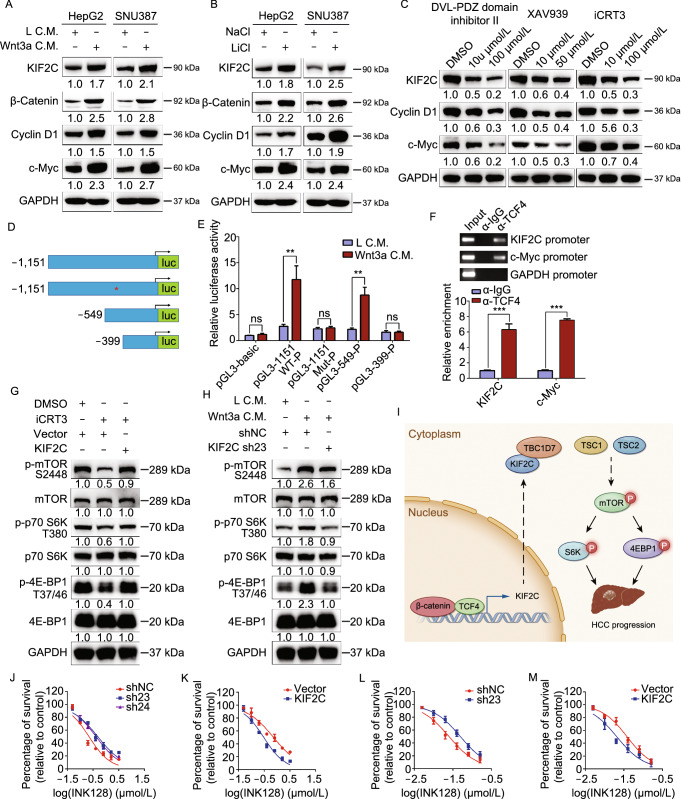Figure 7.
KIF2C expression is upregulated by Wnt/β-catenin signaling in HCC. (A) Western blot analyses showing that activation of Wnt/β-catenin by Wnt3a increases the expression level of KIF2C protein in HepG2 and SNU387 cells. (B) The effect of LiCl treatment on the expression of KIF2C in HepG2 and SNU387 cells as examined by Western blot. (C) Western blot analysis of the expression level of KIF2C protein in SK-Hep1 cells treated with Wnt antagonists (including Dvl-PDZ domain inhibitor II, XAV939 and iCRT3). (D) Schematic illustration of the luciferase reporters driven by the KIF2C promoter and its mutants. (E) Dual-luciferase assay in 293T cells suggests that the putative TCF4 binding site is essential for the responsiveness of KIF2C promoter to Wnt3a treatment. Data are presented as mean ± SD of three independent experiments, ns, non-significant, **P < 0.01, Student’s t-test. (F) ChIP assay performed in SK-Hep1 cells with anti-TCF4 antibody or control IgG. c-Myc acts as a positive control. Data are presented as mean ± SD of three independent experiments, ***P < 0.001, Student’s t-test. (G) Western blot assay revealing that overexpression of KIF2C restores iCRT3-inhibited phosphorylation of mTOR1, p70 S6K and 4EBP1in HepG2 cells. (H) Wnt3a-enhanced mTORC1 signaling is dismissed by knockdown of KIF2C in SK-Hep1 cells. (I) The proposed model of the function of KIF2C in the activation of mTORC1 signaling during HCC pathogenesis. KIF2C is transcriptionally activated by Wnt/β-catenin signaling, then interacts with TBC1D7 to disrupt the stability of the TSC complex, thereby enhancing mTORC1 signaling and HCC progression. (J and K) Cell viability assay (CCK-8 assay) shows the effect of INK128 on KIF2C-depleted SK-Hep1 (J) and KIF2C-overexpressing HepG2 (K) cells. Cells were treated with INK128 for 72 h and measured by CCK-8. (L and M) The effect of INK128 on KIF2C-depleted SK-Hep1 (L) and KIF2C-overexpressing HepG2 (M) cells was detected by colony formation assay

